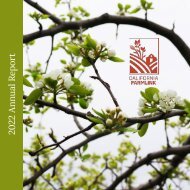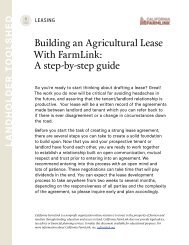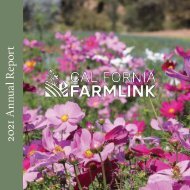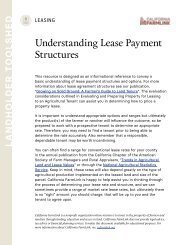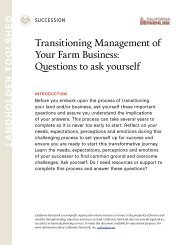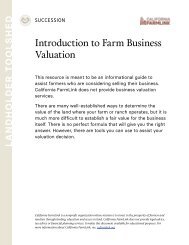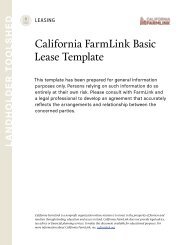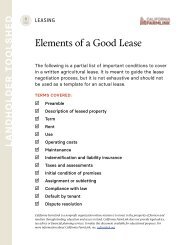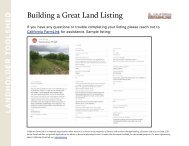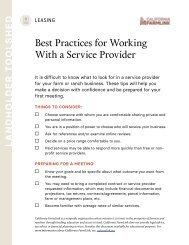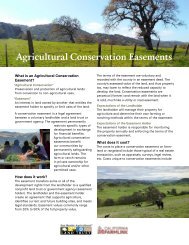Guide to Regenerative Grazing Leases: Opportunities for Resilience
California FarmLink and TomKat Ranch Educational Foundation teamed up to create this resource focused on land leases that support regenerative grazing practices. This guidebook aims to empower private, nonprofit, and public landholders, as well as easement-holders and grazing tenants.
California FarmLink and TomKat Ranch Educational Foundation teamed up to create this resource focused on land leases that support regenerative grazing practices. This guidebook aims to empower private, nonprofit, and public landholders, as well as easement-holders and grazing tenants.
Create successful ePaper yourself
Turn your PDF publications into a flip-book with our unique Google optimized e-Paper software.
CHAPTER 2. <strong>Grazing</strong> <strong>Leases</strong><br />
LEASE BASICS<br />
An agricultural lease is a real estate contract in which a landholder (a.k.a. landowner,<br />
landlord, or lessor) conveys specified agricultural property rights <strong>to</strong> a lessee (a.k.a.<br />
tenant or leaseholder). These may include rights <strong>to</strong> land, water, perennial crops, water,<br />
buildings, housing, hunting, and so on.<br />
A good agricultural lease should include basic contract clauses <strong>for</strong> area and<br />
infrastructure, duration, remuneration, approved uses, responsibilities of each<br />
party, risk management and indemnification, dispute resolution, and termination. A<br />
regenerative grazing lease goes further by establishing the high-level values of the<br />
landholder and lessee. In its main-body clauses as well as any attachments or exhibits,<br />
a regenerative grazing lease outlines the goals, incentives, moni<strong>to</strong>ring pro<strong>to</strong>col, and<br />
communication structures that will support the parties <strong>to</strong> achieve those goals, and <strong>to</strong><br />
adapt when needed.<br />
This guidebook is designed <strong>to</strong> build on existing lease resources, not replace them. The<br />
clauses discussed in this chapter are not comprehensive; rather, they are meant <strong>to</strong><br />
offer ideas, examples, and context <strong>for</strong> a regenerative approach <strong>to</strong> grazing leases.<br />
For background on general agricultural leases, Cali<strong>for</strong>nia FarmLink’s Resource Library<br />
includes a number of accessible guides and templates. For a good foundation in<br />
grazing leases, see UC ANR’s 2020 publication, “A <strong>Guide</strong> <strong>to</strong> Lives<strong>to</strong>ck <strong>Leases</strong> <strong>for</strong><br />
Annual Rangelands." These resources and more can be found in a text box in the<br />
following section, as well as in the Resources section at the end of this guidebook.<br />
Pho<strong>to</strong>: Mark Biaggi, TomKat Ranch<br />
© Copyright 2022 Cali<strong>for</strong>nia FarmLink and TomKat Ranch Educational Foundation<br />
12



